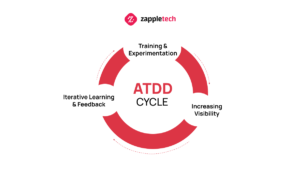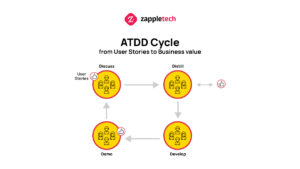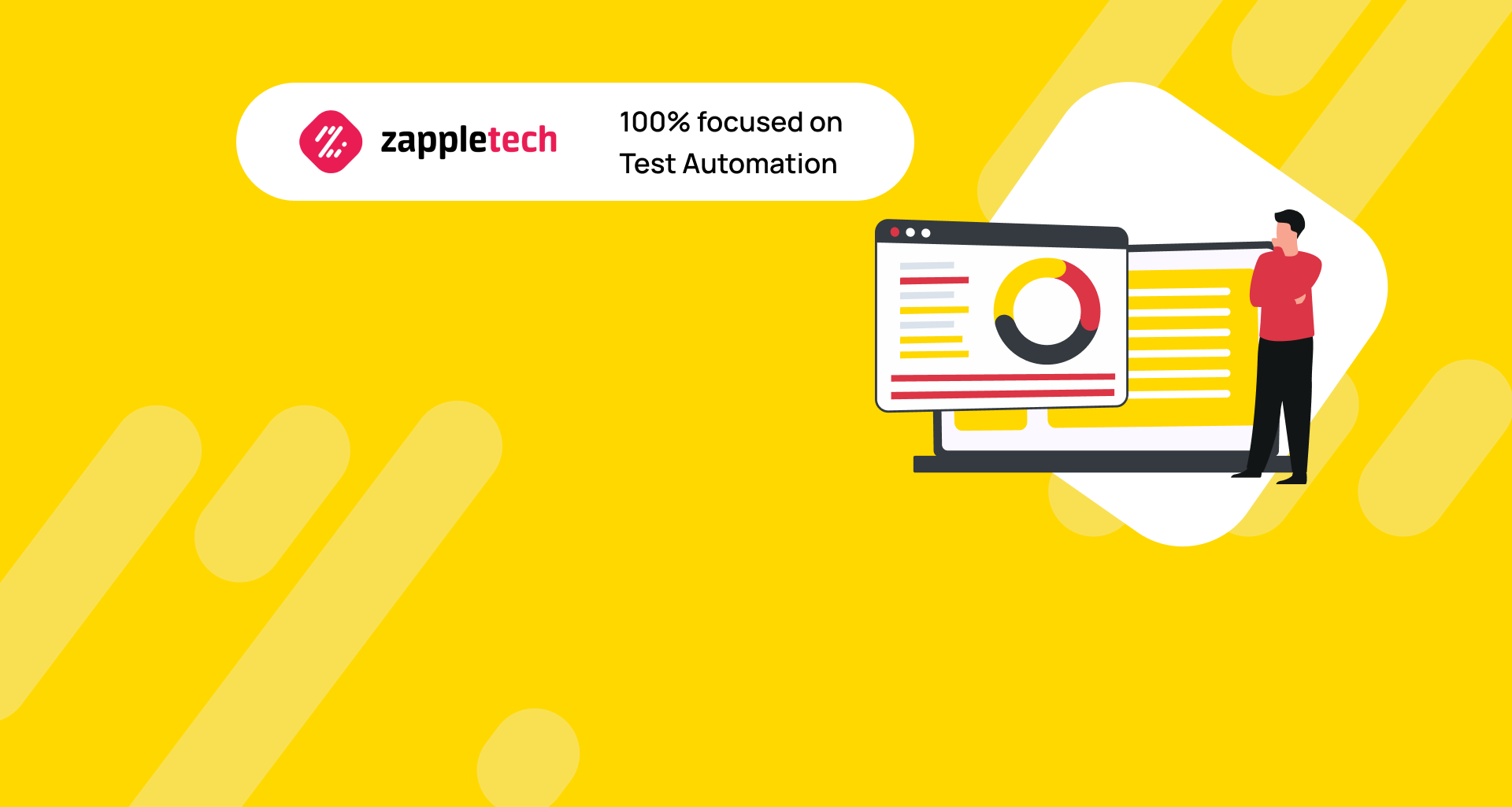
Software testing has different methodologies that correspond to specific goals and purposes. The main thing is to choose the right one, suitable for your tasks and goals. In the testing world, three key methodologies often come up: Test-Driven Development (TDD), Behavior-Driven Development (BDD), and Acceptance Test-Driven Development (ATDD). Each of these methods serves different roles in ensuring software quality, but today we’ll focus on answering the question, what is ATDD and how it benefits development teams.
Acceptance Test-Driven Development (ATDD) is a collaborative approach that brings together business stakeholders, developers, and testers to define acceptance criteria before coding begins. In essence, acceptance test-driven development ensures that all parties have a shared understanding of the project’s requirements from the start. This promotes better communication and reduces misunderstandings, making it easier to deliver a product that aligns with business needs.
One of the key advantages of acceptance TDD is how it fosters cooperation between business and technical teams. Stakeholders, who may not have a technical background, collaborate closely with developers and testers to define how the system should behave from the end user’s perspective. This alignment early in the process makes sure that the final product meets user expectations and is built with clarity.
In Acceptance Test Driven Development (ATDD), teams work together to define clear acceptance criteria before any code is written. This helps ensure that everyone, including developers, testers, and stakeholders, understands what the software should accomplish.Mykhailo PoliarushCEO, ZappleTech Inc.
Additionally, ATDD can be highly effective for agile teams, where continuous feedback and iteration are crucial. By defining tests up front, development teams can better anticipate potential issues and create solutions that fit the acceptance criteria established at the beginning. This iterative approach reduces rework, making the development process smoother and more efficient.
Table of Contents
What Is ATDD?
It is believed that the first person who brought an understanding of what is acceptance test-driven development is Kent Beck, who first mentioned it briefly in his book Test-Driven Development: By Example. He introduced the idea as “application test-driven development,” but he later dismissed the concept.
After six years, in 2006, Dan North introduced the concept of behavior-driven development (BDD), and over time, acceptance test-driven development (ATDD) adopted much of its vocabulary from the BDD methodology. While both methodologies share similarities, ATDD is distinct and has much in common with Specification by Example (SBE) as well.
So, what is ATDD and how does it differ from other testing concepts?
ATDD differs significantly from traditional test-driven development (TDD), primarily in its perspective. TDD is focused on the developer’s point of view, with tests written by developers for developers. ATDD, on the other hand, focuses on the user’s point of view, where acceptance tests are created in collaboration with product owners, testers, and developers. This ensures the software functions as expected for the end user.
Unlike TDD, which is purely developer-centric, acceptance test-driven development is a collaborative process. It bridges communication between business stakeholders and developers by ensuring that the acceptance criteria are clearly defined before coding begins. Another key distinction is that ATDD isn’t just a testing method; it’s a development methodology that relies heavily on automated acceptance test cases to guide the development of production code.
The process begins with developers writing one or more acceptance tests based on the agreed-upon conditions and triggers provided by product owners and the team. These tests serve as a guideline to validate whether the system meets the required functionality. Once the code is written, it’s tested against the acceptance criteria, and any necessary adjustments are made to meet quality standards.
In essence, acceptance test-driven development (ATDD) focuses on user-centric tests that validate the functionality of a system from the end-user’s perspective. This methodology includes four major steps: defining acceptance criteria, writing automated acceptance tests, developing the production code, and refining the tests once the code is complete. By using acceptance test-driven development, teams can ensure that their software not only works technically but also meets the needs of the business and its users.
ATDD Cycle

The next overview of acceptance test-driven development is its stages.
Discuss
In the initial discussion stage of the development process, the team gathers to analyze the tasks and explore the nuances of the project. This phase is crucial for setting clear expectations and ensuring that everyone understands the project goals. The team evaluates the history of similar projects to preemptively identify potential issues, thereby avoiding costly diagnostics and fixes later in the development cycle.
One key methodology employed during this phase is Acceptance Test Driven Development (ATDD). So, what is ATDD? ATDD is a collaborative approach where the development team, testers, and business stakeholders work together to define acceptance criteria before any coding begins. This helps to clarify what is required and aligns the entire team with the desired outcome. By creating acceptance tests, which are written in plain English or presented in simple tables, everyone from developers to non-technical stakeholders can understand the project’s requirements.
These acceptance tests act as a bridge between technical and business teams, ensuring that the user stories are clearly defined and well-understood. Through acceptance test driven development, the team can also gauge the complexity of each user story, reducing the risk of misinterpretation and ensuring that all requirements are met. This collaborative effort helps to streamline communication and create a shared understanding of what success looks like for each feature.
Distill
The second step in Acceptance Test Driven Development (ATDD) involves converting the tests created in the previous step into a format that can be used by the chosen acceptance testing tool. This transformation ensures that the tests are machine-readable and executable. For example, the tests could be represented in wiki tables, custom DSL (Domain Specific Language) code, or any other structure that your tool supports.
ATDD focuses on creating acceptance tests before coding starts. By writing tests that describe the expected behavior, it becomes easier to ensure the final product meets user requirements and catches potential issues early.Sergey AlmyashevCOO, ZappleTech Inc.
By the end of this stage, you will have the initial acceptance tests ready for execution, bridging the gap between the initial requirements and functional testing. Understanding what is ATDD is crucial at this stage, as it involves continuous collaboration between developers, testers, and business stakeholders to ensure that the tests accurately reflect the desired behavior of the system.
Develop
This is the stage where developers take the concept from the earlier discussions and design stages and implement it into a functioning part of the software. Everything that was conceptualized and planned now gets translated into a working function. In the context of acceptance test driven development (ATDD), this is where the agreed-upon acceptance criteria and test cases, which were formulated in collaboration with stakeholders, are coded into the system.
ATDD focuses on ensuring that the code meets predefined expectations. So, what is ATDD? It’s a practice where the development process is driven by creating tests before writing the code itself, ensuring that the function being implemented meets the acceptance tests defined earlier.
Demo
After developers implement a feature, they demonstrate it to stakeholders. This collaborative approach is a key component of acceptance test driven development (ATDD), an agile methodology that focuses on aligning development with business requirements. ATDD ensures that both developers and stakeholders have a shared understanding of the feature’s functionality before it’s fully integrated.
During each meeting, the team discusses not only the current state of the product but also explores ways to improve the development process. This iterative cycle allows the product to evolve based on feedback, enhancing both quality and usability. Understanding what is ATDD is essential because it emphasizes the importance of continuous feedback and testing. The tests are created before the feature is developed and serve as a guide to ensure that the implementation meets the stakeholders’ expectations.
This approach helps in identifying defects early in the process, and each meeting presents an opportunity to explore new options for product improvement. These continuous refinements align with agile principles and help ensure the product is both functional and adaptable to change.
The Need for Acceptance Test-Driven Development
Acceptance Test-Driven Development (ATDD) is a crucial methodology in software development, offering significant benefits by focusing on creating tests from the user’s perspective. This approach ensures that all features are developed based on clearly defined expectations and user needs. One of the main advantages of ATDD is that it aligns development efforts with what the end user actually requires, reducing miscommunication between teams and stakeholders.
A key aspect of what is ATDD lies in the collaboration between developers, testers, and business stakeholders to define acceptance criteria upfront. This process creates a shared understanding of what needs to be developed and tested. Once the specifications are clarified, programmers can turn these into automated, executable tests. This automation guarantees that the system’s functions are implemented correctly, reducing human error and ensuring that the product meets its intended purpose.
Moreover, acceptance test-driven development plays a vital role in increasing productivity by streamlining the feedback process. Automated tests quickly reveal whether new changes in the codebase meet the predefined acceptance criteria. This immediate feedback helps developers fix issues early in the development cycle, preventing costly rework later. Thus, ATDD not only enhances the accuracy of the development process but also contributes to creating more maintainable, user-centered software.
Thus, ATDD helps to avoid duality and ambiguity in requirements. Also, it helps to achieve another goal:
- Develop a product based on stakeholder requests.
- Avoid edits and modifications.
- Create and deliver a worthy product.
Thus, the main conclusion about the need for the ATDD methodology is that it is focused primarily on business and on the user. While the same TDD is not, it helps ensure that the developers have created the right product. At the same time, ATDD helps the team ensure that they will provide the features that the stakeholder expects from them.
What Is Acceptance Test Driven Development Benefits
ATDD brings many benefits to the team, workflow, and business, namely:
- Makes the goal more specific and clear.
- Brings understanding to the requirements of the project.
- Speeds up problems and other issues fixing.
- Reduces the likelihood and number of defects.
- Improves cooperation between team members and distributes responsibilities.
- Increased focus on customers’ needs.
- Simplified management.
So, ATDD contributes to improved team productivity and product quality. The team achieves results much faster and is satisfied with them.
But on the Other Hand…
However, we cannot say that Acceptance TDD is ideal. It also has several problems and nuances that must be taken into account. For example, these are things:
- ATDD can be confused with TDD or BDD. These are different modes with different approaches; such confusion can complicate the work of the developers themselves or even discourage them from doing it.
- This technique needs business support. Some developers generally do not want to work with this method. Sometimes this is explained because they simply do not want to add additional complexity to work.
- One way or another, the team must adapt the tools and workflow as efficiently as possible to achieve the goal set by the product owner.
To Summarize
A common situation in software development is when developers build programs that fail to meet client expectations or business requirements. Acceptance Test-Driven Development (ATDD) is designed to solve this problem by ensuring that the development process stays aligned with client needs from the beginning. ATDD, also known as acceptance testing-based development, involves the use of acceptance tests that define how the software should behave according to the customer’s expectations.
In ATDD, frequent testing and feedback are essential. By constantly refining tests and code based on feedback, teams can quickly adapt to changing requirements and improve the software’s quality.Mikhail BodnarchukCDO, ZappleTech Inc.
What is ATDD? ATDD is a methodology where tests are written collaboratively by developers, testers, and stakeholders before coding begins. This approach allows the team to gather clear user requirements, create tests in a format that everyone understands, and automate these tests. By adopting acceptance test-driven development, the development team ensures that the final product meets the agreed-upon criteria for success.
At ZappleTech, we are experts in testing, agile methodologies, and acceptance testing. If you need testing support or help aligning your product with client expectations, feel free to reach out. We are committed to guiding your product through a successful release with high user satisfaction.







